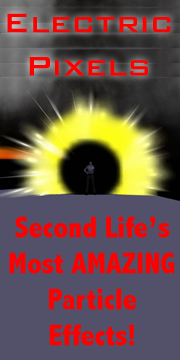 Mainstream media often complains that the population of Second Life is tiny. Perhaps it is, and I constantly see debates on the best way to measure it. But here's my opinion on the matter.
Mainstream media often complains that the population of Second Life is tiny. Perhaps it is, and I constantly see debates on the best way to measure it. But here's my opinion on the matter.
I think that among the general RL population, many people are unwilling or unable to enter Second Life or any virtual world. You all know them – the people who give you a blank look when you try to explain your virtual reality experience. Or worse, they give you that you're-out-of-your-mind look. They say things like, “but it's just pixels on a screen!” or “Why don't you talk with real people?” These folks will never go virtual. And that's why Second Life and other virtual worlds will always attract fewer users than traditional web services. At least until virtual reality concepts become widespread.
I heard a good story that illustrates this common phenomenon when I was introducing a friend, TwelveBar Botha, to Second Life. I told him about my store, my “second life”, how it works, etc. Later, he was relating all this to his senior-age parents:
TwelveBar: “I have a friend who owns land in a virtual world.”
Parents: (skeptically) “Oh?”
TwelveBar: “And he has a store on it.”
Parents: “What does he sell?”
TwelveBar: “Fog!”
And then they “lost it.”
Parents: “What do you mean, he sells fog?!? What kind of a store would sell fog?”
It seems that I have this kind of conversation with somebody in RL almost every week. I almost think that some proportion of the general population has a gene or type of brain structure that seems to prevent comprehension of virtual reality.
Regardless, there are tons of people who can fit into Second Life, and we can see them every time we login and get the concurrent online Second Life count. Say what you want about Second Life problems, but that number just keeps growing, week after week. When I first rezzed just over a year ago, that number hovered around 15,000 or so. Today it's almost four times as large. That's pretty decent growth for one year. I expect it to continue and certainly will break 100,000 within a few months. But how can this growth be sped up?
I believe that the major barrier to growth (aside from the segment of the population that can't grok virtual reality) is the user interface. I'm a techie (if you haven't noticed already) and even I find the interface clunky at times. Here is the historical sequence of events:
- Linden Lab creates Second Life, with the principle that users will build everything.
- Accordingly, the viewer contains all the tools necessary for users to create things.
- Innovative and early adopters willing to suffer through non-optimal clunky builder tools show up and build stuff. Wonderful stuff.
- Non-builder users are attracted by the wonderful stuff and the population swells.
- Non-builders are subjected to the same viewer as originally intended for early-adopter techies, and many give up because it's just beyond their capability to understand how to use these tools.
The solution is obvious. In RL I discussed this issue with Gartner's Virtual Reality Analyst, Steve Prentice, and he had the same idea. Second Life needs a simplified browser suitable for general users, especially those who have no intention of building anything. Builders will find their way to the necessary tools, don't worry about them.
We've seen a couple of steps in this direction so far: First, Linden Lab open-sourced the viewer code, and secondly Electric Sheep built their simplified browser with that code, broadly distributed during the famous (infamous?) CSI episode. What will the next step be? A simplified interface usable from a web browser? We can only hope.


 virtual business, building virtual products and exploring the virtual world.
virtual business, building virtual products and exploring the virtual world.
3 comments:
That's why I don't talk to anybody in RL about SL. Plus we had a lot of bad press in my country, so admitting you are in SL equals to be a child molester to the broad population.
It's amazing how poorly focused the press can be. If you spend any time at all in SL, you will find wonderful, amazing and useful things. But you rarely see that in the headlines. Sigh, just like real life...
They don't really sell fog, they sell fog machines, or fog textures, or fog making material or whatever.
Post a Comment